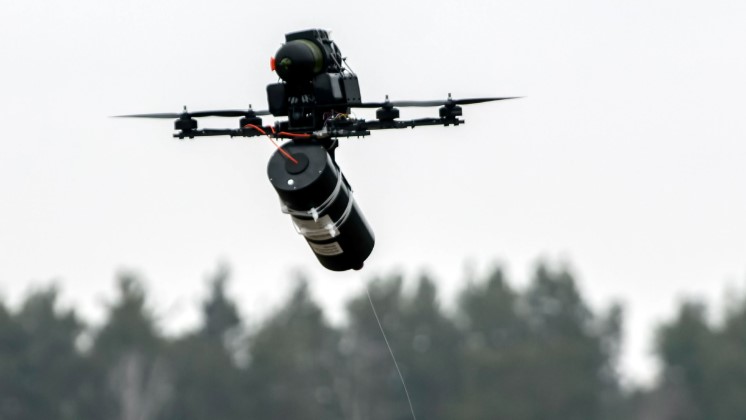Russian mobile air defense units have begun using laser-based systems to intercept Ukrainian long-range strike drones. Earlier reports showed that these systems were tested on decoys during training exercises. New video footage confirms that Russian forces are now actively using these weapons in combat operations.
Russian Forces Deploy Laser Weapons Against Drones
Defense Express published video footage of a Russian laser system destroying a Ukrainian FP-1 strike drone on August 13. Since its public debut in May, Ukrainian forces have used the FP-1 in deep-strike operations against targets within Russian territory. The destruction of the FP-1 shows that high-energy laser systems can operate effectively in active conflict zones.
Russian forces are deploying systems believed to be part of a program called LASS, which stands for Low-Altitude Laser Defending System. In other words, LASS is a short-range laser weapon designed to intercept aerial targets. Analysts say that the China Academy of Engineering Physics developed LASS.
For instance, the weapon delivers a concentrated power output of 10–20 kilowatts and requires about 10 seconds of sustained targeting to disable an aerial target. As a result, it can destroy targets up to 1.5 kilometers away and further cause optical disruption at distances up to 3 kilometers.
Berlin fury after Chinese laser targets German aircrew in critical maritime operation
Military experts consider LASS a short-range air defense asset. It functions similarly to traditional anti-aircraft artillery but is potentially more precise and effective than the heavy machine guns often used on mobile units. The system can target low-flying drones before they reach critical areas, providing rapid response against aerial threats.
How the Laser Systems Operate
Laser weapons work by concentrating energy into a powerful beam aimed at a target. When a drone remains in the beam for several seconds, the laser can damage sensitive components like cameras, sensors, or electronics, causing the drone to crash. This method allows forces to neutralize unmanned aerial systems precisely without using explosive projectiles.
Russian forces deploy LASS systems on mobile vehicles to quickly target areas where drones operate. Analysts point out that drones flying at low altitudes are particularly vulnerable to laser attacks because they stay within the system’s effective range longer.
Bone-Crushing Blow? US Bill Threatens 500% Tariff on India, China Over Russian Oil
Russia has also demonstrated a prototype laser weapon designed to counter drones. Russian authorities unveiled the weapon at the All-Russian Conference on Protecting Civilian Infrastructure from Unmanned Aerial System Attacks in March, aiming to defend critical infrastructure from small aerial threats. These developments indicate a broader effort to integrate directed-energy weapons into defense strategies.
The operational use of mobile laser systems marks a notable advancement in modern warfare. By targeting drones like the FP-1, these systems aim to reduce the effectiveness of long-range aerial strikes and enhance the protection of key areas.
Countermeasures and Tactical Considerations
Experts suggest that overcoming laser defenses may require redesigning drones or using weapons less vulnerable to directed-energy attacks. For instance, cruise missiles and ballistic systems could offer an advantage against such short-range laser defenses.
Secondly, increasing drone speed and altitude is another potential countermeasure. By flying higher and faster, drones spend less time within the effective range of laser weapons, therefore reducing the risk of interception. Similarly, military engineers have modified Shahed-type UAVs in previous conflicts to improve their survivability.
The deployment of high-energy laser weapons highlights how advanced technology is playing a growing role in modern combat. Above all, forces now use directed-energy systems operationally to counter unmanned aerial threats, moving them beyond their previous experimental stage.
While LASS and similar systems currently serve short-range defense roles, their precision, speed, and effectiveness make them significant additions to air defense networks. Analysts continue to monitor their performance, particularly in response to the increasing use of long-range drones in conflict zones.

